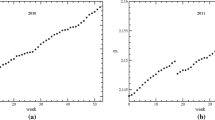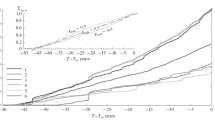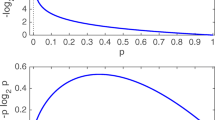Abstract
Entropy is a state function. The entropy increase principle tells us that under isolated or adiathermal conditions, the spontaneous development of a system from a state of non-equilibrium to a state of equilibrium is a process of entropy increase, in which a state of equilibrium corresponds to a state of maximum entropy. When the system is in a state of equilibrium, it is also at its most chaotic and disordered. The occurrence of earthquakes can be classified as a random event and can be described using entropy. Earthquakes occur in the most disordered way, indicating that entropy has reached its maximum value, so we can use the Maximum Entropy Method to determine the distribution of earthquakes that occur within a certain area curing a particular period of time. Results show that the formula representing the relationship between seismic frequency and magnitude (based on data and experience) is in fact a negative exponential distribution under given restraints and supposing seismic entropy is set as the maximum value. Therefore, we can theoretically explain the origin of the relationship between seismic frequency and magnitude.
Similar content being viewed by others
References
Akin H (2006) The topological entropy of nth iteration of an additive cellular automata. Appl Math Comput 174(2): 1427–1437
Emanuel KA (1995) The behavior of a simple hurricane model using a convective scheme based on subcloud-layer entropy equilibrium. J Atmos Sci 52: 3960–3968
Feng LH (1998) Application test of matter element analysis in earthquake forecast. Acta Seismol Sin 11(6): 745–750
Goltz C, Bose M (2002) Configurational entropy of critical earthquake populations. Geophys Res Lett 29: 51–51
Guo LF, Garland M (2006) The use of entropy minimization for the solution of blind source separation problems in image analysis. Pattern Recogn 39: 1066–1073
Li QL, Yu L, Hao BL (1979) Space-time scanning for relation of seismic frequency–magnitude. Seismological Press, Beijing, pp 1–22
Nanda AK, Paul P (2006) Some results on generalized residual entropy. Inf Sci 176: 27–47
Nicholson T, Sambridge M, Gudmundsson O (2000) On entropy and clustering in earthquake hypocentre distributions. Geophys J Int 142: 37–51
Ningxia Seismological Bureau (2006) Seismological directory in Ningxia. People Press in Ningxia, Yinchuan, pp 172–274
Wang B (1988) Talking entropy. Entropy and cross science. Meteorological Press, Beijing, pp 19–22
Zhang XW, Ma L (1992) Entropy meteorology. Meteorological Press, Beijing, pp 114–125
Zhou SM, Gan JQ (2006) Constructing accurate and parsimonious fuzzy models with distinguishable fuzzy sets based on an entropy measure. Fuzzy Sets Syst 157(8): 1057–1074
Author information
Authors and Affiliations
Corresponding author
Rights and permissions
About this article
Cite this article
Feng, LH., Luo, GY. The relationship between seismic frequency and magnitude as based on the Maximum Entropy Principle. Soft Comput 13, 979–983 (2009). https://doi.org/10.1007/s00500-008-0340-x
Published:
Issue Date:
DOI: https://doi.org/10.1007/s00500-008-0340-x




